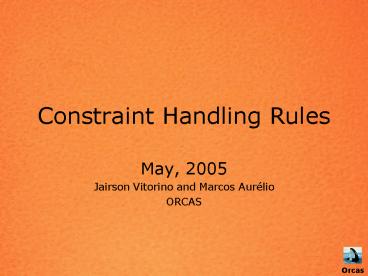Constraint Handling Rules - PowerPoint PPT Presentation
Title:
Constraint Handling Rules
Description:
Logic Programming Constraint Solving. CHR: Language for writing ... Commited choice: When the engine picks a rule ... Commited-choice and Confluence ' ... – PowerPoint PPT presentation
Number of Views:90
Avg rating:3.0/5.0
Title: Constraint Handling Rules
1
Constraint Handling Rules
- May, 2005
- Jairson Vitorino and Marcos Aurélio
- ORCAS
Orcas
2
Contents
- CHR
- Introduction
- Syntax
- Operational Semantics
- Example
- CHR-?
- Introduction
- Operational Semantics
- Example
- References
3
CHR
- Constraint Handling Rules
4
Introduction
- Constraint Logic Programming
- Logic Programming Constraint Solving
- CHR Language for writing Constraint Solvers
- rule-based
- Flexible to define new domains
- Constraint resolution via rules (declarative)
5
Introduction
- CHR
- Rewrite rules (pattern matching simplify rules)
- Plus propagation rules
- Similiar to production rules (forward chaining),
but with a well defined semantics - CHR disjunction is turing-complete, first-order
knowledge language and monotonic
Current CSP software packages have fixed domains
and constraints, answer CHR
6
Syntax
- Constraints
- User-defined
- Ex noattack(Q1,Q2), connected(X,Y,3)
- Built-In
- Ex AgtB, AB, ground(A)
7
Syntax typical rule
H1,...,Hn ltgtG1,...Gn B1,...,Bn
Multiple Heads
Guards
Body
Both constraint categories
(Only built-in)
(Only user-defined)
Commited choice When the engine picks a
rule there will not be any backtracking, so in
CHR order matters!
8
Syntax
- Rules
- Simplification
- H1,...,Hn ltgt G1,...Gn B1,...,Bn
- Propagation
- H1,...,Hn gtG1,...Gn B1,...,Bn
- Simpagation
- H1,...,Hn / Hn1,...HnnltgtG1,...Gn B1,...,Bn
9
Operational Semantics
State
User defined Constraints Store (UDCS)
Logical meaning ?y Goal ? UDCS ? BICS
Goal or query
Built-in Constraint Store (BICS)
CHR Program Or Base Rule
CHR ENGINE
Final State true or false
10
Operational Semantics
- Transitions
- Solve and Introduce
- Propagate
- Simplify
- Commited-choice and Confluence
- The confluence property of a program guarantees
that any computation starting from an arbitrary
given initial state, i.e. any possible order of
rule applications, results in the same final
state.
11
Operational Semantics
- Transitions (Solve)
Built-in
12
Operational Semantics
- Transitions (Introduce)
User-defined
13
Operational Semantics
- Transitions (Simplify)
- U1,U2 ?B1 U3,U4
Rule in CHR program
14
Operational Semantics
- Transitions (Propagate)
- U1,U2 ?B1 U3,U4
Rule in CHR program
15
Operational Semantics
- Transitions (Simpagate)
- U1,U2 / U5?B1 U3,U4
Rule in CHR program
16
Example
- CHR Program
- XltY ltgt XY true.
- XltY,YltX ltgt XY.
- XltY,YltZ gt XltZ.
17
Example
18
Example
19
Example
20
Example
(Logo CltA equivale a BltA)
true
21
Example
Final State
22
CHR-?
- Constraint Handling Rules with Disjunctions
23
Introduction
- Allows disjunctions in the bodies of rules and in
goals - It can be used as a general-purpose logic
programming language
24
Operational Semantics
- State
- Minimal set of subgoals
- Ex a ? (b ? (c ? d)) ? e
- Logical meaning ?y A
- Initial State
- Final State
- Successful
- Failed
25
Operational Semantics
- Transitions (Solve)
26
Operational Semantics
- Solve
- To normalize the predefined means to produce a
new state G that is (according to the logical
theory T0) logically equivalent to the state G
27
Operational Semantics
- Transitions (Simplify)
- b ? c ?f ? g
28
Operational Semantics
- Transitions (Split)
29
Example
- bird ? albatross ? penguin.
- penguin ? flies ? false.
30
Example
31
Example
Final State (no derivation step can be applied)
32
Example K-coloring map
main() ltgt true color(X1),
color(X2), color(X3),
color(X4),
connected(X1,X2),
connected(X1,X3),
connected(X3,X4),
connected(X2,X4).connected(X1,X2) ltgt
ground(X1), ground(X2), X1X2 false.color(X)
gt true (X1 X2 X3).
33
Example 4-Queens
main() ltgt true c(X1), c(X2), c(X3), c(X4), //
rainhas na(X1,X2,1),
na(X1,X3,2), na(X1,X4,3),
na(X2,X3,1), na(X2,X4,2),
na(X3,X4,1), sol(X1,X2,X3,X4).na(X,Y,D) ltgt
ground(X), ground(Y) PYD, MYD, ne(X,Y),
ne(X,P),ne(X,M).c(X) ltgt true (X1 X2
X3 X4).sol(X1,X2,X3,X4) ltgt ground(X1),
ground(X2), ground(X3), ground(X4)
write(X1), write(X2), write(X3),
writeLn(X4).
34
Reference
- Theory and practice of Constraint Handling Rules
(http//www.pst.informatik.uni-muenchen.de/persone
n/fruehwir/jlp-chr1/jlp-chr1.html) - A languagem for experimenting with Declarative
Paradigms (http//citeseer.ist.psu.edu/611754.html
)
35
Reference
- XSB Prolog
- http//xsb.sf.net
- The ECLiPSe Constraint Logic Programming System
- http//www.icparc.ic.ac.uk/eclipse/
- WebCHR
- http//bach.informatik.uni-ulm.de/webchr/
- JACK Java Constraint Kit
- http//www.pms.ifi.lmu.de/software/jack/

